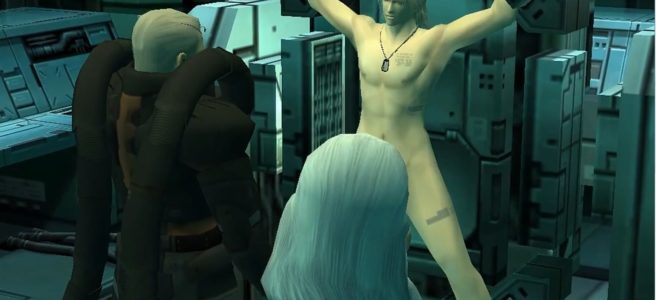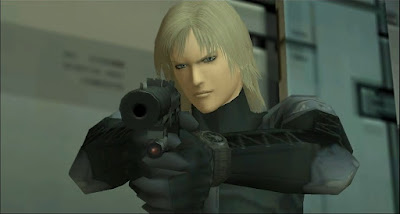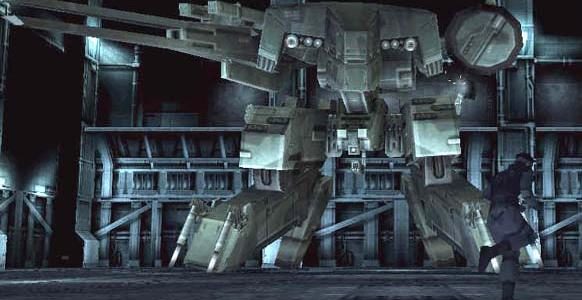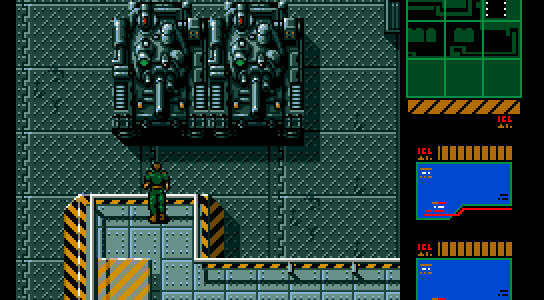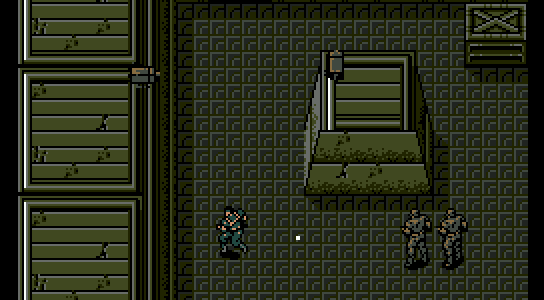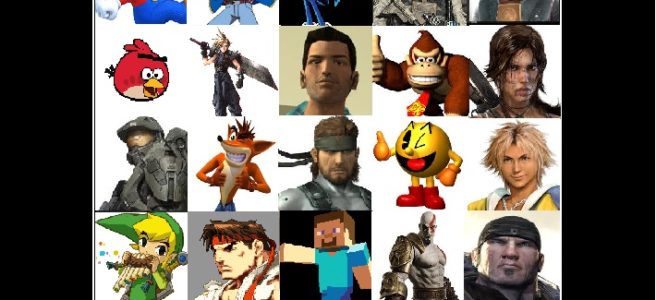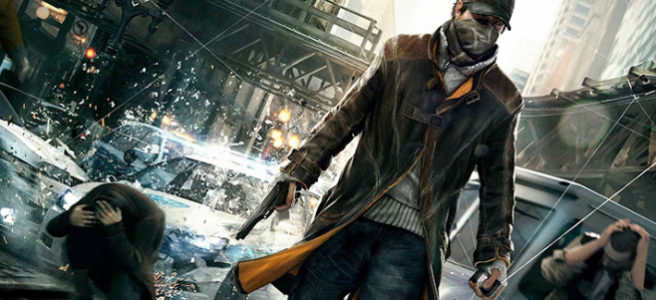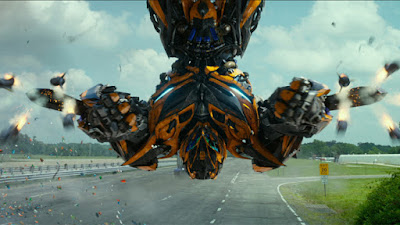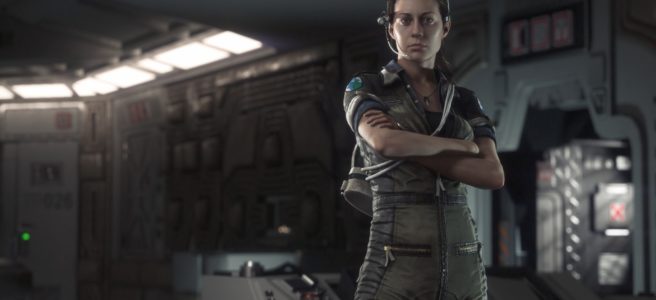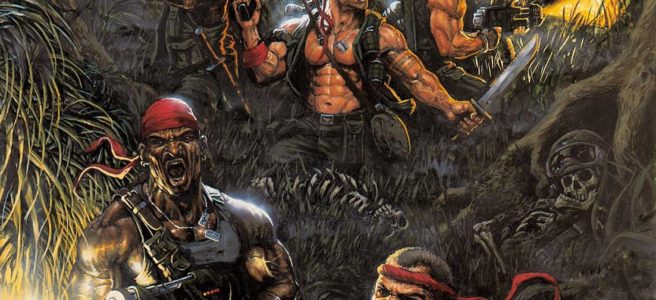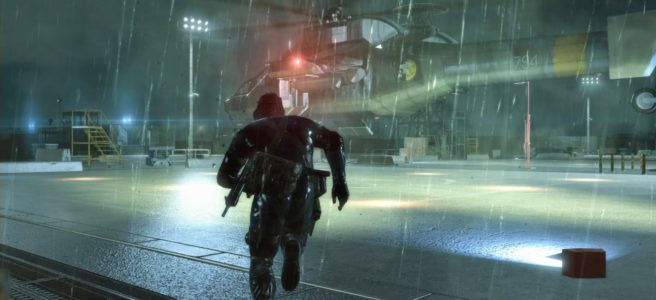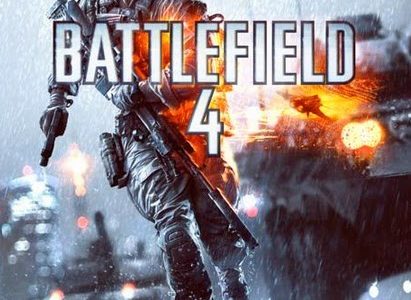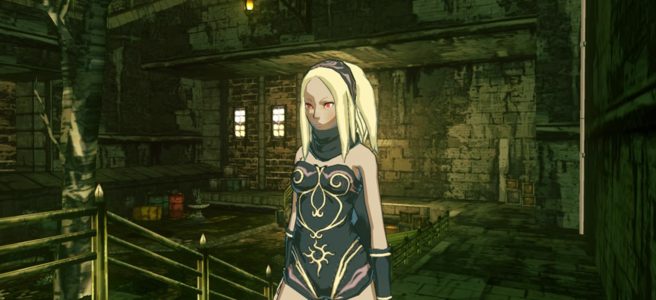Welcome back to the Metal Gear retrospective! In this entry we’re going to cover the fourth game in the franchise, 2001’s Metal Gear Solid 2: Sons of Liberty! After the massive, genre-defining success that was Metal Gear Solid, would Hideo Kojima’s big follow-up manage to deliver on the expectations of fans? Read on to find out…
Before we go on further, in the interest of disclosure I feel that I should mention that when I first played this game 7 or 8 years ago it was easily one of my least-favourite entries in the Metal Gear franchise (in fact, the second most popular post on this blog is about me complaining about how poorly-handled the main character is). I had only beaten it the one time though, so the replay required for this retrospective has given me a much-needed refresher. I was especially curious to replay it because, in recent years, the game has gotten a major reassessment and I have heard it hailed as Kojima’s “masterpiece”. Has time softened my attitude? That’s another thing for you to keep an eye on as we continue onwards…
(I originally played this game on PS2. For the purposes of this retrospective, I played the Substance re-release contained in the HD re-release on PS3. In case you’re curious, the only real differences between the standard release and Substance are a bunch of VR missions and some very negligible differences in the environments.)
DEVELOPMENT
After the massive success of Metal Gear Solid cemented Solid Snake’s exploits in popular culture, the world was eager for a follow-up as the game left many plot threads dangling. Shortly after completing Metal Gear Solid, development on a sequel began in 1999. Not really having another story in mind kind of came back to bite Kojima in the ass as he tried to figure out what direction to take the game.
The game was plagued with real-world issues which made settling on a story difficult. Apparently the game was originally meant to involve nuclear weapons inspections in Iraq and Iran, with Snake having to take out Metal Gear on board an aircraft carrier within a time limit. Liquid Snake was also supposed to be the villain, probably because Kojima expressed regret over killing him off when he found out how popular he was. However, this plot was dropped after about a half a year into the project when tensions in the Middle East made such a story unappealing. The aircraft carrier concept was carried over into the final game though, being reworked into Sons of Liberty‘s prologue “Tanker” chapter.
The final game also received some major cuts as it was set in Manhattan and released mere months after 9/11. As a result, a major scene near the end of the game depicting Arsenal Gear crashing into Manhattan was removed, as was a scene where Raiden causes an American flag to cover Solidus Snake’s body. Raiden’s name was also altered in the Japanese version, as there were concerns that “Raiden” was too similar to “Bin Laden”. Bizarrely, the game was originally going to be titled Metal Gear Solid III, with the Roman numerals representing the Manhattan skyline. Naturally, if they had actually decided to carry through with this, then 9/11 would have screwed this idea as well.
Also, no mention of Sons of Liberty‘s development would be complete without mentioning the marketing. Kojima pulled off one of the biggest trolls ever when he centered all of the game’s hype around Solid Snake. Raiden was a periphery character in the marketing and the people who actually noticed him, naturally, expected that he would be nothing more than a supporting sidekick…
PLOT SUMMARY
Picking up 2 years after the Shadow Moses incident, Snake and Otacon have gone on to create Philanthropy, an NGO with the express purpose of exposing and preventing Metal Gear proliferation. Otacon receives intel on a new type of Metal Gear, codenamed RAY, which is being transported through the New York Harbour by the US Marines. Snake sneaks aboard the tanker with the intention of photographing RAY and exposing it to the public. Shortly after arriving, the tanker begins to be swept and captured by Russian mercenaries led by Sergei Gurlukovich. Snake makes his way past the mercenaries to the bridge, where he discovers that the tanker is headed 500 miles past the Bermudas to test RAY. Snake then encounters Gurlukovich’s pregnant daughter, Olga, who engages Snake in a gun battle. Snake tranquilizes her, but is unexpectedly photographed by a Cypher UAV after the fight.
Snake then heads into the core of the ship, fighting his way past the mercenaries until he finds the remaining Marines listening to a presentation by commander Scott Dolph about Metal Gear RAY’s capabilities, unaware that the tanker has been hijacked in the interim. Snake manages to get his pictures of RAY and uploads them to Otacon before Revolver Ocelot suddenly arrives and interrupts the meeting. Sergei Gurlukovich and his soldiers arrive and hold the Marines at gunpoint. Sergei celebrates that they will use RAY to restore Russia to glory, but Ocelot turns on him – he reveals that he will deliver it to “The Patriots”. Ocelot then shoots Dolph and Gurlukovich as well as anyone who tries to stop him. He then blows a hole in the tanker’s hull using SEMTEX and hijacks RAY. Snake tries to stop Ocelot, but his sudden appearance causes Ocelot to begin to spasm and speak like Liquid Snake. It turns out that Ocelot had grafted Liquid’s arm onto his severed hand following the Shadow Moses incident, but that this has had the side effect of allowing Liquid’s consciousness to possess Ocelot. He then escapes in RAY, apparently leaving Snake and most of the Marines and Russian mercenaries dead from the sinking.
The game then fast forwards 2 years later. The tanker’s sinking has been covered up, being claimed as an environmental disaster which has necessitated the construction of an offshore cleanup facility called the “Big Shell”. During a government inspection, a terrorist group calling themselves the “Sons of Liberty”, led by disavowed special forces unit Dead Cell, capture the Big Shell using Gurlukovich mercenaries and take the 30 people hostage – including the US President, James Johnson. A single soldier from FOXHOUND, code-named “Raiden”, is sent in to rescue the hostages while two SEAL Teams attempt to secure the President. Raiden is told that the Sons of Liberty are demanding $30 billion or they will destroy the Big Shell, causing the worst environmental disaster in history in the process.
As Raiden gets aboard the Big Shell via underwater infiltration, he immediately discovers an intruder has beaten him into the facility, leaving unconscious guards in their wake. Raiden’s commanding officer, The Colonel, orders Raiden to proceed with caution. He also reveals that Raiden’s girlfriend, a systems analyst named Rosemary, will be aiding them on this mission. Raiden is incensed by this unexpected revelation, but reluctantly goes along with it. Listening in on the SEAL Teams, Raiden discovers that Team Alpha has located the President but their transmission is cut off as they are attacked. Raiden hurries to help them, but discovers that the unit has been massacred by a mysterious, knife-wielding Dead Cell member named Vamp and that the President is missing. Vamp attacks Raiden, but is prevented from killing him as a man dressed like a SEAL arrives and fires at him. Vamp escapes and the SEAL introduces himself as Iroquois Pliskin.
Raiden leaves Pliskin behind before moving to SEAL Team Bravo to try to catch up to the President. However, he finds SEAL Team Bravo engaged in a gunfight with Dead Cell member, Fortune. Despite firing hundreds of rounds and a grenade launcher at Fortune, the SEAL Team is baffled as their shots curve around her and the grenade fails to detonate. Fortune and Vamp secure the President and Fortune fires a railgun at SEAL Team Bravo, killing everyone and destroying much of the connecting bridge in the process.
The Colonel then informs Raiden that C4 has been placed all around the Big Shell. Raiden is ordered to disarm the C4 as his new priority objective. To help with this, he locates bomb disposal expert Peter Stillman, who was brought aboard with SEAL Team Bravo, and runs into Pliskin again. Stillman explains that the C4 is the doing of Dead Cell member Fatman, a protege of Stillman’s. Following Stillman’s advice, Raiden and Pliskin spread out across the Big Shell to locate and disarm the C4 charges. They have a suspiciously-easy time doing this, until Pliskin discovers that there is an enormous amount of C4 placed on the lower levels of Struts A and H. Raiden disarms the C4 in Strut A, but Stillman is killed when attempting to disarm explosives in Strut H. Attempting to leave Strut A, Raiden is ambushed by Fortune. He is unable to land a shot on her, but manages to buy himself an opening when a deflected bullet curves into Vamp’s head, apparently killing him. Fortune is distraught, allowing Raiden a chance to escape and confront Fatman, who has issued him a challenge. After Raiden leaves though, Vamp is revealed to still be alive. Raiden then tracks down Fatman, who reveals that he is not interested in Dead Cell’s objectives. He only wanted to surpass Peter Stillman and become the greatest bomber in history by destroying the Big Shell. He begins planting bombs all across their battlegrounds, but Raiden disarms them and kills Fatman.
With the threat of the bombs eliminated, The Colonel then orders Raiden to rescue the President. As he moves to do so, he is confronted by a cyborg ninja named “Mr. X”. Mr. X informs him that one of the hostages, a secret service agent named Richard Ames, knows the President’s location. Mr. X also tells him that the Sons of Liberty have nuclear strike capability, since the Big Shell is a cover-up site for a new Metal Gear. Raiden then makes his way to Ames, who tells him the President is in the Shell 2 core and is cooperating with the terrorists. When questioning Ames about the $30 billion ransom, Ames explains that there is no threat or ransom being made – the terrorists have always planned to launch a nuke over Manhattan to cause an EMP pulse and “liberate” it. Raiden and Ames are then interrupted by Ocelot, who begins accusing Ames of being a spy before Ames dies of a heart attack. Ocelot then attempts to capture Raiden, but is saved by Mr. X, who allows him to escape.
Raiden begins heading to the Shell 2 core, but is stopped by a man calling himself Solid Snake. Pliskin arrives in a helicopter piloted by Otacon and begins firing at the imposter. “Solid Snake” escapes and climbs aboard a Harrier gunship, piloted by Vamp. The Harrier then begins to strafe Raiden, Pliskin and Otacon, but Raiden manages to shoot it down. “Solid Snake” loses an eye from the attack, but before the Harrier can crash, Metal Gear RAY arrives and catches it before fleeing. Pliskin reveals that he is the real Solid Snake and that he faked his death 2 years earlier using Liquid Snake’s body to create a false DNA match. He explains that he and Otacon have come to the Big Shell to stop the new Metal Gear prototype and to rescue Otacon’s sister, Emma Emmerich.
Raiden then makes his way through the ruined Shell 2 struts and proceeds into the core. He makes contact with President Johnson, who is resigned to his fate. He begins to tell Raiden about The Patriots, a secret organization which rules over America and the rest of the world. He claims that The Patriots are run by twelve men called the Wisemen’s Committee, and that the leader of the Sons of Liberty was the previous President, George Sears aka Solidus Snake, the third clone from the “Les Enfants Terrible” project. He reveals that Solidus was behind the Shadow Moses incident, but was forced to step down from his presidency by The Patriots. This led Solidus to want to challenge The Patriots for supremacy, whereas President Johnson just wanted to be allowed to join their organization, using the terrorist takeover as leverage to be brought into the organization. Johnson also reveals that the Big Shell was a cover-up, but not for the construction of Metal Gear RAY – it was actually housing an enormous, mobile fortress called Arsenal Gear which was defended by mass-produced, unmanned RAYs. While Arsenal Gear had control over the US military network and nuclear arsenal, its true purpose was to censor the Internet and digital communication by using an AI called “GW”. Johnson gives Raiden a disc containing a worm cluster which will eradicate GW and tells him to locate Emma Emmerich to use it. He then orders Raiden to shoot him, but Raiden refuses. When he tries to wrestle the gun from Raiden, he is unexpectedly shot by Ocelot, who then immediately leaves.
After conferring with Snake and Otacon, Raiden heads into the basement levels of the Shell 2 core to locate Emma. On the way, he is confronted by Vamp. The pair battle in a small purification chamber, but Raiden overcomes him, sending him sinking into the depths of the sea. Raiden then makes his way to Emma, who reveals that she was the creator of the GW AI, but that it isn’t yet complete as it lacks the ability to properly judge and filter information.
With the lower levels of the core beginning to sink, Raiden discovers that Emma is afraid of water after a childhood accident where her step-father drowned himself to death, and nearly dragging her down with him. Raiden convinces Emma to overcome her fears and leads her out of the sinking core. With most of Shell 2 destroyed, Raiden and Emma make their way to the perimeter oil fence to get back to Shell 1. Emma makes her way across with Raiden and Snake providing cover fire with their PSG-1 sniper rifles. However, just before she reaches Shell 1, Vamp appears from the sea and grabs her. Raiden shoots Vamp, but he is too late – Vamp stabs her, leaving her mortally wounded. Snake and Raiden hurry into the Shell 1 core with her to meet up with Otacon and input the virus and destroy GW. Emma and Otacon reconcile just as she succumbs to her wound, but the virus fails to install as they had expected. With the virus failing to stop GW, Snake and Raiden deduce that the only thing they can do now is get inside of Arsenal Gear and take out Solidus while Otacon flies the hostages back to shore. Snake then mentions to Raiden that they will need a hand getting inside, at which point Mr. X appears and reveals that they are actually Olga Gurlukovich in disguise. Olga unexpectedly knocks Raiden out.
Raiden awakens naked, strapped to a torture bed with Solidus and Ocelot watching over him. Solidus (who is now wearing an eyepatch over his lost eye) reveals that he actually knows Raiden – he was an orphaned child soldier who he commanded during the Liberian Civil War. He was Solidus’ greatest student, which earned the nickname “Jack the Ripper”. After Solidus and Ocelot leave, Olga arrives and tells Raiden that The Patriots kidnapped her child at birth. She reveals that she was ordered to aid him in his mission or The Patriots would terminate the child. She tells him that Snake is nearby and then orchestrates his means for escape. Raiden makes his way through Arsenal Gear as The Colonel’s transmissions become increasingly strange. He finally meets up with Snake, who apologizes for his earlier “betrayal”, but claims that it was necessary to get aboard Arsenal Gear. He then provides Raiden with a high-frequency blade, courtesy of Olga, and the pair battle their way into the core of the fortress. Otacon then reveals that The Colonel wasn’t a real person, they were actually just a Patriot AI who has been manipulating Raiden this whole time. Raiden begins to question what is real and what isn’t when Fortune arrives. She accuses Snake of killing her father, Scott Dolph, 2 years earlier during the tanker incident. Snake tells Raiden to go on ahead while he deals with Fortune and Raiden obeys.
Raiden makes his way to a platform where Solidus calls out to him, claiming that Raiden is just a pawn in the S3 plan, a “Solid Snake Simulation” which would use VR training to mold Raiden into a warrior on the same level as Solid Snake. Raiden is then forced to fight Arsenal Gear’s entire fleet of Metal Gear RAYs. He destroys many of them, but there are so many of them that he is unable to keep fighting. Solidus then emerges and is about to kill Raiden when Olga suddenly appears. She saves Raiden’s life, saying that his life, and consequently her child’s, is more important than her own as Solidus shoots her in the head with his P90. Solidus then tries to get the RAY fleet to finish off Raiden, but they begin to malfunction due to Emma’s virus. Furious, Solidus destroys the remaining RAYs just as Fortune arrives with Snake as her prisoner.
Solidus then reveals his true plan: to use GW to locate The Patriots and eliminate them one-by-one. Meanwhile, the other Sons of Liberty would unintentionally serve as a diversion using Arsenal Gear. Ocelot laughs at this and reveals that everything that has happened was actually orchestrated by The Patriots all along, with all the similarities to the Shadow Moses incident being the real S3 plan to mold Raiden into a Solid Snake-calibre soldier. The only thing they hadn’t anticipated was the arrival of the real Snake, which is why The Colonel had continually cautioned Raiden not to rely on him as he wasn’t a part of the mission. Ocelot then shoots Fortune, revealing at her supernatural abilities were the results of Patriot electromagnetic technology. Ocelot climbs aboard Metal Gear RAY and attempts to kill everyone, but Fortune summons enough strength to stand and somehow manifests psychic powers to deflect the missiles before dying. Outraged, Ocelot prepares to finish the others when his arm begins to spasm and he is possessed by Liquid Snake once again. Liquid Ocelot reveals that he is the one who leaked information on Arsenal Gear to Philanthropy in order to draw Snake out to the Big Shell and allow him to possess Ocelot for good. With Ocelot’s knowledge on The Patriot’s location, he intends to destroy them and establish Outer Heaven once again. He sets Arsenal Gear on a collision course with Manhattan and then escapes in RAY. Breaking free from his restraints, Snake dives off of Arsenal Gear in pursuit.
Solidus and Raiden are helpless to stop Arsenal Gear as it crashes into New York City and obliterates much of the Lower West Side of the city before coming to a stop at Federal Hall. Solidus and Raiden fall onto the roof of Federal Hall where Solidus begins to explain his motives to Raiden. The Les Enfants Terrible children were engineered without the ability to reproduce, meaning that Solidus won’t be able to pass his genes on to another generation. He explains that all that he wants is to be remembered in history, but if The Patriots remain in control, they will suppress knowledge of him or twist it into a monstrosity. He reveals that his desires are borne not out of greed, but out of a desire to restore freedom which has been snatched away by The Patriots.
The Patriots AI then contacts Raiden via Codec. They explain that the digital age has led to the proliferation of “junk information” which will remain forever. Previously, society advanced by selectively retaining information which became what we know as history. With the “truth” of our present freely available to future generations, this knowledge will threaten social progress. The Patriots reveal that the S3 plan does not stand for “Solid Snake Simulation”, but rather “Selection for Societal Sanity” and that the Big Shell incident was a test for their crisis management capabilities. Believing their judgement to be superior, The Patriots feel that they are in a position to determine what information will be passed on to future generations, claiming that humans prefer courtesy and political correctness over the acceptance of unpleasant truths. They then order Raiden to kill Solidus, threatening to kill Olga’s child and Rosemary if he fails to comply. Solidus then reveals that he needs to kill Raiden as well, because the nanomachines in his head can be used to determine the location of The Patriots. Provoking Raiden, he also reveals that he was the one who killed Raiden’s parents. The pair battle with high-frequency blades, but Raiden overcomes his spiritual father and severs his spine. Solidus falls from the roof of Federal Hall and lands at the feet of a statue of George Washington before he succumbs to his wounds.
Raiden climbs down and Snake appears, revealing that he still has Emma’s virus disc. He deduces that, since it was programmed to censor the names of The Patriots’ leaders, it would therefore have some sort of indicator as to what those names were in the first place and that they will hunt down The Patriots with this information. Raiden tries to come with him, but Snake tells him to stay and do what he needs to. Rosemary then appears as Snake departs, and the two are reunited as they vow to make a new life together as Rose is pregnant with Raiden’s child.
In the post-credits sequence, Otacon announces that he has deduced the identity of The Patriots, but is perplexed to discover that all 12 of them have been dead for over 100 years and that 1 of them is one of Philanthropy’s biggest contributors. Snake realizes that this information is a false lead, leaving them unable to figure out how to proceed…
GAMEPLAY & DESIGN
Much like previous Metal Gear games, Sons of Liberty iterates on the mechanics of previous games, bringing with it some pretty big improvements. The biggest addition is the first-person shooting controls, which make combat in the game significantly more fun and viable. This also opens up a number of new infiltration techniques, from hold-ups, to expanded chokeholds, to using enemies as human shields. First person controls require quite a bit of acclimation to use effectively though. For one thing, the control scheme itself is really convoluted. You have to hold R1 to go into first person mode, then square to aim a weapon before releasing square to shoot. However, if you want to lean then you also have to press L2/R2 (or both), meaning that you can easily be pressing upwards of 5 buttons to perform a complex action (R1 for first person mode, square to shoot, L2+R2 to lean upwards and X to stand up in one single attack). The game also makes prodigious use of pressure-sensitive controls, which make assault rifles and grenades extremely difficult to use effectively. Basically, you have to half-press the square button to bring up the rifle and then press it fully to fire, meaning that you can easily fire it by mistake. This basically forces you to rely on the single-shot pistols as much as possible. You can also holster a weapon without firing by slowly depressing the square button, but this is not always successful – I’d hate to be on a non-lethal playthrough and then accidentally shoot an enemy in the head because of this stupid control scheme. There are also no sensitivity options and it can be hard to line up a shot, especially in the heat of combat. That said though, the first person aiming makes both combat and sneaking far more fun and strategic than it was in previous Metal Gear games, even if the controls make getting used to it a hassle.
Sons of Liberty makes a lot of smaller improvements to the gameplay as well though. The camera isn’t nearly as awful anymore and tends to show more of the environment. The first person aiming helps here quite a bit as well, meaning that you’re not being forced to shoot at enemies off-screen all the time. The game also applies significantly more cinematic camera angles which display more useful sightlines. Unfortunately, this is a double-edged sword, as the cinematic angles also leave you completely blind much of the time. As a consolation, peeking around corners and pressing against walls is now strongly incentivized to proceed safely, and the right analog stick can now be used to move the camera in this view.
The game also opens up more sneaking options which make gameplay styles much more freeform. One new addition which I love is the addition of the roll, which can be used to get into cover quickly or to stun enemies. You can also shoot security cameras, which is a long-overdue addition for the series. Unconscious, dead or held-up soldiers can also be shaken to steal items, although I didn’t find this strategy to be particularly necessary during my playthrough as equipment is provided in sufficient numbers and whether an enemy will actually drop something seems to be random. However, one very fun and challenging bonus objective is the ability to acquire dog tags from enemies. If you hold up an enemy, you can force them to give you their dog tag, which was a very fun diversion which actually tests your sneaking skills quite a bit! I also quite like the introduction of “adult literature” which can be used to distract guards and set up traps. It’s also worth noting that Sons of Liberty is the first Metal Gear game to allow for 100% non-lethal gameplay and to make it challenging yet viable with the introduction of non-lethal chokeholds and the tranquilizer pistol.
Sons of Liberty also stands out from its predecessors due to the absolutely enormous graphical leap between it and Metal Gear Solid. While Metal Gear Solid had very rudimentary shapes and suggestive textures that left a lot to the imagination, Sons of Liberty is very detailed, particularly its character models. This is also aided by the game’s attention to detail, which is absolutely insane. While the environments can be very claustrophobic and small, they are jam-packed with little details which bring them to life. For example, during the Tanker chapter, rain bounces off of objects in the environment and the Marines’ hoods actually “blow” in the wind, which really sells the setting. These little touches just permeate throughout the entire game and are frankly mind-blowing even in comparison to modern games: tranquilizers are actually visible and stay in enemies’ bodies, walking in puddles will leave footprint trails, ice cubes actually melt over time, you can slip and fall on bird shit, swarms of bugs crawl around on the floor, shell casings and spent magazines will litter the floor during gun battles, trying to roll up stairs will knock you flat on your ass and even walking in front of a urinal will cause it to flush! That last detail really struck me as an example of the insane desire for authenticity which no other game developer would even bother with or which no player would even expect to be included.
Despite the gameplay improvements that it makes though, Sons of Liberty can’t help but take a couple steps backward. For one thing, during the Plant chapter, the Soliton radar system now has to be manually activated every time you enter a new area. This might have been done due to complaints that the radar was too important in Metal Gear Solid, but withholding it for arbitrary reasons is not a good solution. Having no radar makes infiltrating new areas a very unwelcome experience as you attempt to track down the area’s terminal as quickly as possible. This also makes the cinematic camera angles a pain in the ass, since you often won’t even know if there’s an enemy nearby and can easily stumble into enemies unfairly.
Sons of Liberty also suffers from having a really boring environment in the Plant chapter, especially in comparison to Shadow Moses and the Tanker chapter. The Big Shell is a mostly-uniform environment which only changes somewhat inside each strut and the cores. It can be difficult to remember which room is which due to the layout of the shells. The Big Shell is also a very puny map – you only really get to explore Shell 1, because Shell 2 gets blown up, meaning that you only get to see the outside of a couple struts, the core and a little bit of one of the struts as you head down the ladder to the oil fence. Subsequent games have been kind to the Big Shell though, as its design has been reused and lent gravitas through retcons. Players who have played through latter Metal Gear games might attribute the Big Shell with additional meaning which was not actually intended when it was first released.
There is also an extended set piece which many people have expressed quite a bit of frustration over. This is the swimming sequence which ends up also being an escort mission as Raiden leads Emma out of Shell 2. Personally, I found these swimming segments to actually not be all that difficult, but when it turns into an escort mission it definitely starts to become frustrating. Emma’s O2 meter is pathetically small, meaning that you have to travel between oxygen pockets as fast as possible or Emma will start losing health. She’s not much better on land either, because she makes Raiden extremely slow and he can’t shoot when guiding her (plus all that they did in this section was obviously slow down both of their movement animations which just look awkward). This is thankfully not a major frustration as you can let her go to shoot at cypher drones or guards, meaning that you really don’t have to worry about her dying on you constantly. The only time you have to worry about her wandering into enemy fire is during the sniping section on the oil fence, when she will just keep walking into claymores and gunfire while you wrestle with the awful, random scope sway that has carried over from Metal Gear Solid. Thankfully, the game is balanced in such a way that you shouldn’t be forced to redo these sections much (if at all), but those who hate water levels and escort missions in particular will not be thrilled by this extended set piece.
Sons of Liberty also carries over some of the series’ persistent legacy issues. Foremost among these are the card keys, but thankfully they have been streamlined to the point of near obsolescence. Sons of Liberty carries over Metal Gear Solid‘s improvements to this system, giving you “one security card to rule them all” at any time. In addition, the number of key card rooms in the game is significantly reduced, being cut down to basically just an armoury, the access point to the oil fence and a couple story-based progression points. Finally, the key cards don’t even need to be equipped in order to access a key card room, making me wonder why they even bothered to include them in this game at all. Thankfully, this marks the last time that key cards are a major progression method in a Metal Gear game, and they will not be missed.
The Plant chapter also features quite a bit of backtracking, but it has been utilized in a much more bite-sized, sneaky manner due to the map layout. The Big Shell is laid out in a hexagonal-shape, meaning that you can go around its circumference to get to objectives. In a typical playthrough, you’re probably going to circle the Big Shell twice before backtracking a couple more times along its right side to get into and out of the core. Thankfully, due to the relatively small size of the Big Shell, it is quite easy to navigate and does not feel particularly intrusive or like a transparent attempt to pad out the game’s length.
Sons of Liberty also has to have arguably some of the most challenging enemy AI in the entire franchise. For one thing, their vision cones have been subtly extended – the cones visible on the radar are just the area where you will be instantly spotted, but guards can also spot you from outside this area and prompt an investigation. In addition to the enemy’s detection tricks from previous games, bodies also no longer disappear as soon as they die, which means that you have to quickly hide bodies out of sight (including in lockers as a new feature) or enemy patrols will discover them. In this way, killing is actually actively discouraged as you only get about 10-15 seconds to move about freely before the enemy’s HQ radios them for a status report and then sends in a heavily-armed patrol unit to investigate and increase security. These patrol units are extremely imposing with their riot shields, body armour and shotguns and can pose a significant problem if you end up getting spotted. They are also just impressive to witness as they actually use SWAT formations and room clearing tactics, which are highlighted with a cinematic overlay in the top right corner where you can witness their sweep in action. If you do get spotted though, you actually now have a few intense seconds to save your ass as enemies have to radio for backup. You can actually tip the odds in your favour by shooting the enemy’s radio, but normally I’ll just go for a tranquilizer headshot. This addition makes alerts a little fairer, while simultaneously making getting spotted much more intense as you attempt to stop enemies from bearing down on you from all angles. Finally, for the first time in the series’ history, enemy conditions are persistent if you leave an area – if you knock out or kill a guard and then come back within a short time frame, then they will still be in the same place.
As a side-note, I also noticed some really strange, but minor, issues with the HD edition which I’m not sure were present in the original release. For example, during the iconic opening cinematic of the game, the framerate drops significantly when car headlights are shown. I’m not sure if this is just poor optimization or what, but you’d think that if they could render the headlights on PS2, such lighting effects would be trivial on PS3. More concerning though is the lag with the Codec, which can vary anywhere from 1 to 3 seconds every single time you use it. Considering how frequent Codec calls are in this game, this is a pretty noticeable irritation. The upscaling from fullscreen to widescreen has also been handled rather inelegantly. During the sniping section as you try to cross from Shell 1 to Shell 2, I noticed that the camera is supposed to zoom in on semtex and controllers, but it inexplicably zooms in above both of them, suggesting to me that the remaster team didn’t bother to make sure that the camera was properly lined up during this cinematic. Radar overlays (such as oxygen pockets and the bomb “scents”) are also not properly synced with the radar itself, as you can easily notice that they are both moving at different speeds when displayed on the radar. These are rather small issues that hardly sink the game, but they are noticeable and made me wonder just how much work really went into the remastering of this game.
This brings us though to what is probably the biggest “gameplay” issue with Sons of Liberty: the wildly imbalanced gameplay-to-cutscene ratio. The Tanker chapter is a great opening to the game with a gameplay-cutscene ratio on par with Metal Gear Solid. It took me about 2 leisurely hours to get through, with probably around 3/4 of that consisting of actual gameplay. However, during the Tanker chapter, the extended cutscenes and codec calls just become overbearing as you are often forced to sit through 10-30 minute long cutscenes before you get to play again. I’d estimate that my first hour on the Big Shell was probably 90-95% cutscenes. You basically get bombarded with a new explanatory cutscene every time you enter a new area or when an event happens. For example, when you reach the President you sit through a 20-30 minute long cutscene before you finally get back in control… and then as soon as you exit the room you have to sit through another 10 minutes of cutscenes. The big showdown with Metal Gear RAY also marks one of the most ridiculous sets of cutscenes as literally every character betrays one another over the course of 40 minutes and the truth of one single plot point (the S3 plan) is revealed to be another deception three separate times. The Plant chapter took me around 9 hours to complete, but I’d be shocked if more than 4 of those hours involved actual gameplay – the game seriously has that many extended cutscenes breaking it up. Making things worse is the fact that you can’t pause any of them, so hopefully you don’t have to go to the bathroom in the middle of one or you’re going to have a hell of a time trying to figure out the game’s plot.
If Metal Gear Solid represented Kojima’s the first steps into mature storytelling, then Sons of Liberty is the overconfident, adult strides. While the game’s actual narrative is convoluted mish-mash (which I will get to later), there’s no denying that Kojima really knocks the ball out of the park by imbuing Sons of Liberty with deep, existential themes. Remember, this was back in 2001, when gaming was still seen as a nerdy pursuit, when video game storytelling was still a tertiary concern outside of JRPGs and when “are games capable of being art?” was a very hotly debated subject. Sons of Liberty is often cited as the first “Post-Modern” video game, and honestly it is a very apt descriptor due to its deconstructions of society and the relationship between the player and the game itself. As a result, the fourth-wall breaks which had been a part of the series since the beginning actually become integrated into the message of the game itself:
Snake: “War as a video game – what better way to raise the ultimate soldier.”
Raiden: “So you’re saying that VR is some kind of mind control?”
Raiden: “This is like a bad dream I can’t wake up from. […] This doesn’t feel real.”
In some ways, Raiden himself seems to be meant to be a representation of the player. At the beginning of the game, you are asked to fill out your name, which becomes Raiden’s name on his dog tags in the final cutscene. Raiden also makes numerous references to VR training and simulations, which we are clearly meant to understand as being a reference to the player’s own experiences playing video games. As the game progresses though, Raiden begins to gain his own personality and desire to live his own life as he chooses. When the player ceases to control Raiden in the final cutscene, Raiden symbolically throws the dog tags away, signifying that he is now free to make his own decisions.
Furthermore, Kojima constantly messes with player expectations in order to leave them off balance and question the “reality” of the game itself. The big reveal that Raiden is the player character is perhaps the first, and most obvious, example of this. The sequence where Raiden runs around naked in Arsenal Gear while The Colonel calls him with such amazingly quotable lines as “I hear it’s amazing when the famous purple stuffed worm in flap-jaw space with the tuning fork does a raw blink on Hara-Kiri Rock. I need scissors! 61!” is probably the best example though, as by this point the player has settled into the game when it suddenly leaves them entirely flabbergasted. The fourth wall breaks become constant as well, as The Colonel urges Raiden to “turn off the console” – a line which has a double-meaning, as it is also a direct reference to the original Metal Gear. Metal Gear and Metal Gear Solid are both invoked during this sequence, which messes with the player’s own history with the series by directly breaking the “immersion” which so many players consider to be a crucial aspect of taking a game seriously. The game also gives you a number of fake game over screens as you progress through areas of Arsenal Gear which literally describe you as advancing up backwards out of its asshole. It’s absolutely bizarre and basically impossible to play through without being constantly reminded of the fictional construction of the game itself.
In fact, the constant references to the fictional nature of the game have prompted many players to question whether we are intended to take the game’s events “literally” or rather whether it is intended to be a VR simulation. They also cite the numerous “references” to Metal Gear Solid as an example of this, that Sons of Liberty is indeed simulating the player’s memories of the first game. For one thing, I think this is missing the forest for the trees – I believe that the game is trying to make the player aware that the game is game, rather than it being a game within a game. I believe very strongly that the events of the game are meant to be taken as things which are actually happening within the game’s world, because otherwise much of the narrative serves absolutely no purpose. For example, there is absolutely nothing in the Tanker chapter to suggest that the events of it are anything other than the “truth”. From there, the pieces of the VR simulation theory just begin to fall apart, because if the Tanker chapter actually happened then why would that be then followed up by a VR simulation? How does that make narrative sense? Where is the closure? I think that some people would suggest that things like this and the numerous nonsensical plot twists that populate the game’s narrative are also meant to make absolutely no sense and simply exist to make the players confused on an existential level. This, however, just gives Kojima simultaneously too much and too little credit for his storytelling abilities in my opinion, when realizing that the VR simulation is the game that you are literally playing is the actual intent is so much easier to believe.
Sons of Liberty also builds on the genetics theme from Metal Gear Solid, evolving it to the next most logical level with the concept of “memes“. Put simply, memes are like the cultural version of genes, where information, concepts and ideas are passed on from generation to generation. Much like genes in Metal Gear Solid, the concept of memes are what drives the motivations of many of the characters in Sons of Liberty. One of the more subtle examples of this is the character of Fatman. It can also be discerned that Fatman turns on Dead Cell and becomes an agent of The Patriots because he believes that doing so will allow him to become remembered as the greatest bomber in all of history. After all, if he remained a part of Dead Cell, then his existence and ambitions would have been covered up and controlled by others.
Perhaps the most obvious characters to be linked with the meme theme though are Les Enfants Terrible, Solid and Solidus. During Sons of Liberty, Snake often encourages Raiden with his personal philosophies that he has developed over the course of his previous adventures. One particularly noteworthy quote that he makes though is Gray Fox’s dying words:
Solid Snake: “We’re not tools of the government, or anyone else. Fighting was the only thing I was good at, but at least I fought for what I believe in.”
This is quote is very important for a few of reasons. First of all, it demonstrates Snake’s evolution as a character. In Metal Gear Solid he fought for little more than a sense of obligation, but by Sons of Liberty he is now a member of an NGO. Perhaps due to Gray Fox’s dying words, he has literally decided to dedicate his life in service of his morals. This quote also demonstrates the use of memes in action. Gray Fox may not have passed on his genes, but he has passed this particular meme on to Solid Snake, who has adopted it as a personal mantra. In this way, Gray Fox becomes “immortal” in a sense and is remembered. By passing it on again to Raiden, Snake perpetuates the meme, much like how genes are passed on to the next generation, although he also adapts it for his own understanding, putting his own touches on the meme:
Snake: “Find something to believe in, and find it for yourself. When you do, pass it on to the future.”
It’s also very noteworthy that the Snakes are so concerned with memes since they have all been engineered to be infertile. With no chance of passing on their genes, the Snakes will inevitably die out and be forgotten in a few short decades if they do not pass on their memes. Solidus makes this very clear in his surprisingly affecting speech with Raiden on top of Federal Hall:
Solidus Snake: “Jack, listen to me. We’re all born with an expiration date. No one lasts forever. Life is nothing but a grace period – for turning our genetic material into the next generation. The data of life is transferred from parent to child. That’s how it works. But we have no heirs, no legacy. Cloned from our father, with the ability to reproduce conveniently engineered out. What is our legacy if we cannot pass the torch? Proof of our existence – a mark of some sort. When the torch is passed on from parent to child… it extends beyond DNA; information is imparted as well. All I want is to be remembered. By other people, by history. The Patriots are trying to protect their power, their own interests, by controlling the digital flow of information. I want my memory, my existence to remain. Unlike an intron of history, I will be remembered as an exon. That will be my legacy, my mark on history. But the Patriots would deny us even that, I will triumph over the Patriots, and liberate us all. And we will become the Sons of Liberty!”
While we are led to believe that Solidus has megalomaniacal, unapologetically evil ambitions throughout the game, when he reveals that this has been his motivation all this time, it is a shockingly human and sympathetic desire: the simple wish to not be forgotten when he is gone. Most people wrestle with this sort of existential crisis, but Solidus has had the deck stacked against him at birth due to genetic tampering and the meddling of an unstoppable force pushing back against him. This actually makes his objectives seem almost noble in the end, despite the fact that he’s still a total bastard who raised child soldiers, killed Raiden’s parents and executed Olga Gurlukovich in cold blood…
Of course, much of the plot of Sons of Liberty revolves around The Patriots, a shadowy organization which exerts power through information control. Their ultimate goal throughout the game is to make their version of history the officially recognized history for future generations, meaning that they essentially want a monopoly on memes. Immediately after Solidus explains his motivations, The Patriots contact Raiden and explain their motivations in an extremely long-winded Codec call, which is clearly intended to set his ideology against theirs. Some of the most important quotes as are follows:
Patriot AI (switching between depictions of The Colonel and Rosemary): “We started with genetic engineering, and in the end, we succeeded in digitizing life itself. But there are things not covered by genetic information.”
Raiden : “What do you mean?”
Patriot AI : “Human memories, ideas. Culture. History. Genes don’t contain any record of human history. Is it something that should not be passed on? Should that information be left at the mercy of nature? We’ve always kept records of our lives. Through words, pictures, symbols… from tablets to books… But not all the information was inherited by later generations. A small percentage of the whole was selected and processed, then passed on. Not unlike genes, really. That’s what history is, Jack. But in the current, digitized world, trivial information is accumulating every second, preserved in all its triteness. Never fading, always accessible. Rumors about petty issues, misinterpretations, slander… All this junk data preserved in an unfiltered state, growing at an alarming rate. It will only slow down social progress, reduce the rate of evolution. […] Not even natural selection can take place here. The world is being engulfed in ‘truth.’ And this is the way the world ends. Not with a bang, but a whimper. We’re trying to stop that from happening. It’s our responsibility as rulers. Just as in genetics, unnecessary information and memory must be filtered out to stimulate the evolution of the species.”
Raiden: “And you think you’re qualified to decide what’s necessary and not?”
Patriot AI: “Absolutely. Who else could wade through the sea of garbage you people produce, retrieve valuable truths and even interpret their meaning for later generations? That’s what it means to create context.”
Raiden: “I’ll decide for myself what to believe and what to pass on!”
Patriot AI: “But is that even your own idea? Or something Snake told you? That’s the proof of your incompetence, right there. You lack the qualifications to exercise free will.”
In short, The Patriots believe that memes are just as much a force of human evolution and adaptation as genes are traditionally thought to be. With the theoretically-limitless capabilities of digital archiving at our disposal, The Patriots believe that this sudden and permanent influx of “junk” ideas will eradicate the traditional natural selection of memes and lead to the end of humanity (in the same way that a white supremacist would believe that the propagation of “inferior” genes will lead to the destruction of humanity). As a result, The Patriots believe that they must curate information in order to maintain the development of society. This sets them at odds with Solidus: Solidus believes in personal liberty and the ability for humans to chart their own legacy, whereas The Patriots believe that only they have the necessary qualifications to determine what is in the best interest of social progression. These are all extremely interesting philosophical ideas which were very topical at the turn of the millennium and, honestly, are still very relevant today. Within the last few years, people have been beginning to really understand the permanence of the Internet as their lives are archived on social media, as election campaigns are fought with smear campaigns built on quotes from upwards of a decade ago and when shamed individuals have their entire life ruined by one moment of misunderstanding which ends up defining their existence forever. If Sons of Liberty was misunderstood and unappreciated back in 2001, this is likely because it was almost a decade before its time.
While the themes in Sons of Liberty are handled in a rather masterful fashion, the same can’t be said of the actual narrative they occur within. There are some very interesting moments in the game’s story, but I think it would be fair to say that the plot is told in an unnecessarily convoluted and sometimes just plain insane manner. The Tanker chapter is quite interesting as it does a great job of setting up its circumstances and then providing forward momentum which keeps the player invested. However, as I said in the gameplay section, the plot turns into a lot of busywork throughout the majority of the Plant chapter, which isn’t helped by the fact that that it is made very obvious to the player that nearly everyone is lying to them up until Raiden meets President Johnson. For example, from the second that Iroquois Pliskin is introduced, everyone knows that he is actually Solid Snake so all the “oh is he really a SEAL?” questioning is kind of pointless. In addition, one of the first lines of the Plant chapter reveals that The Colonel is bullshitting Raiden as he tells him that the Big Shell was built to clean up an environmental disaster, while the player knows that this is not the case. Throw in the fact that Raiden’s personality is largely withheld from the player until the last couple hours of the Plant chapter, and you get a recipe for lots of unsatisfying busywork as you try to get to the points where the plot gets interesting.
That said, even when the story starts picking up near the end, the game suddenly goes into an overdrive of plot twists. Over the course of one single stretch of cutscenes in the game’s final hour, we are treated to the following plot twists, many of which are introduced and then reversed shortly after their introduction (and note that the S3 plan is revealed and altered three separate times in this one stretch): Raiden is a product of the S3 plan, using VR to turn him into the next Solid Snake! Solidus actually wants to capture Arsenal, not the Big Shell! No wait, he didn’t want Arsenal, Fortune did and she was going to betray him! He really wanted the names and location of the Wisemen’s Committee! But wait, Ocelot screwed them all over because The Patriots were using them to pull off the S3 plan in real time! And Fortune wasn’t really psychic, it was all electromagnets that she had hidden on her for years now without knowing! But wait, it turns out that she actually does have psychic powers! How fortuitous! But then Ocelot betrays himself and then goes to destroy the Patriots as Liquid Ocelot! Wait, Solidus wasn’t a bad guy at all, he was trying to free the world from The Patriots! But wait, The Patriots are trying to keep the world’s information from destroying humanity! Plus the S3 plan is actually an information control system that has basically nothing to do with Raiden at all! As you can no doubt see, this is the distillation of batshit insanity and basically requires multiple playthroughs to even begin to understand what is going on.
In addition to the ridiculous number of plot twists, Sons of Liberty also introduces some strange and/or problematic plot points. The most obvious of these has to be the Liquid arm twist, which is often derided as one of the most insane twists in the entire series. The idea of having Liquid Snake be able to psychically possess Ocelot is insane, even by the standards of Metal Gear‘s magical realism, as there is no real precedent for it… and that’s not even getting into the question of why Ocelot would even use Liquid as an arm donor in the first place. There’s also an incredibly strange and unnecessary plotline where Otacon tearfully explains that he was banging his stepmother, which just comes out of absolutely nowhere. I know Kojima wanted to explain why Otacon felt guilty that Emma almost drowned, but was that really the best he could come up with (that’s not even mentioning the incestual vibes between Otacon and Emma)? Kojima also sort of writes himself into a corner with Solidus – the idea that a clone of Big Boss would become president and that no one would notice this is one of the more ridiculous plot holes in the series. This was silly enough when it was revealed in Metal Gear Solid, but Sons of Liberty makes it worse when it is revealed that Solidus has been training child soldiers and that at least one of them was living in America and surely would have recognized him at some point or another. When people talk about how crazy and impenetrable Metal Gear stories are, they are referring specifically to the reputation set by Sons of Liberty. Most other games in the series can be fairly complex, but are not too difficult to follow on their own merits.*
Despite all this serious talk about heavy themes and games as art, Sons of Liberty still manages to be one of the funniest games in the whole franchise. In addition to aforementioned plot points which include literally running naked up Arsenal Gear’s asshole as The Colonel wigs out, Kojima also throws in tons of little details and fun abilities for the player to discover. One odd example of this is the ability to interact with Codec calls. If you press R1 or R2 when someone is talking to Raiden, he will actually say something to taunt or praise the speaker (such as “uh huh?”, “you’re crazy!” or “you’re so cute!”). In addition to the already-silly cardboard box, the game also gives you the ability to distract enemies with pornographic magazines, which is just hilarious when you manage to pull it off. I think my favourite trolling moment though is when you have to sneak through the Marines in the Tanker chapter. In addition to just messing with them by changing the projector screen displays, there is also a moment where Scott Dolph gets the Marines to set off a false alert. This was a huge troll moment for me way back when I first played this game and is one of my fondest memories of that playthrough as I seriously thought I had been spotted by everyone for a moment before I burst out laughing at Kojima’s ingenuity. Then there’s all the other little, often juvenile, details that you’ll come across, such as slipping and falling to your death on bird shit, getting pissed on by a guard and having the President of the United States come up to you and grab your balls and say, with surprise, that you’re a man. You also get a trophy for staring at bikini models in the game which is, appropriately, called “Snake Beater”. In all, this adds up to a very silly experience which kind of goes at odds with the otherwise-serious story and themes, but which no doubt makes it more enjoyable to play through.
Sons of Liberty is also unique for having two new Metal Gear models featured in the game, although both of them twist the definition of “Metal Gear” pretty significantly. The first, and most obvious, is Metal Gear RAY. This model has a very badass and iconic design. Whereas REX is bulky and imposing, RAY is sleek and efficient. However, it differs from traditional Metal Gears by not being nuclear-equipped. Rather, it is actually meant to be a counter to other Metal Gears. The other Metal Gear in the game is Arsenal Gear, which is an extremely unorthodox design for the series. It has more in common with a spaceship or a submarine rather than a Metal Gear. After all, isn’t the whole point of a Metal Gear for it to be a bipedal, nuclear-equipped tank? The only part of that which fits Arsenal Gear is the nuclear-equipped bit. It’s also ends up being a rather throwaway plot point by the end of the game when The Patriots reveal that they basically threw away billions upon billions of dollars on its construction for basically no actual purpose.
Similarly, Sons of Liberty builds upon the other returning cast members to flesh them out quite well. I have already shown how Snake has evolved in some detail, but Kojima also goes a long way to turning Snake into the ultimate badass now that the player doesn’t get to play as him. Like Ocelot, he is always just ahead of Raiden. This is best demonstrated in the opening of the Plant chapter, where Raiden is literally a minute too late to witness Snake kick the shit out of all the guards. Otacon also gets a bit more development which shows that he has become a less-passive individual since the Shadow Moses incident (although the stepmother revelation is still totally baffling). Despite being a secretly new character, The Colonel actually plays on the players’ memories of Colonel Campbell with his extremely mechanical and impersonal dialogue. I heard one commenter claim that they suspect that The Colonel’s voice acting is intentionally robotic, and having played through the game with this in mind, I definitely have to agree. His performance and lines can be extremely odd, which strikes me as being something which was deliberately done to clue in the player to his true intentions with a certain amount of subtly.
As for the new characters, they are more of a mixed bag. Raiden was a major point of contention for a lot of fans when this game was first released. I have written about it before and, while there were the idiots who just didn’t like his androgynous looks, I think that most of them just didn’t like his personality, especially when compared to the much better fleshed-out Solid Snake. Honestly though, Raiden is fairly decent once he finally gets his backstory near the end of the Plant chapter. Up until that point though, he lacks an interesting personality and can be kind of petulant at times. To be fair though, his “whininess” is usually in response to reasonable stimuli, such as being asked to perform bomb disposal despite not being trained for such a dangerous task. By the ending though, Raiden begins to assert his own history and makes his own decisions, which makes him significantly more endearing. He also gets a pretty strong character arc by the ending, which couldn’t possibly be wiped out by any sequels which would reverse all of his character development… nope, not a chance…
I think the real issue though for most people is Rosemary. She isn’t as bad as I remembered, but she has been written as a bit of an overly-emotional wet blanket and only brings out the whiniest parts of Raiden. You only really have to listen to her when you save the game, but if you are someone who saves frequently you might want to start holding down the triangle button to skip their “relationship talk”.
Emma Emmerich has some similar issues. She is actually kind of an entertaining character who has much more chemistry with Raiden than Rosemary ever displays. There’s also the fact that Emma is wracked with PTSD due to almost drowning as a child when her father tried to commit murder-suicide. This alone makes her more endearing and makes her otherwise annoying qualities more forgivable. During the escort mission, Emma becomes a major burden on the player as she flat-out refuses to help herself and slows down Raiden significantly as he tries to get her to safety. This can make Emma very annoying to deal with, even if her actual characterization seems to be otherwise positive.
If Rosemary and Emma are both rather poor female characters though, then Olga Gurlukovich makes up for them in spades. I had forgotten just how awesome Olga is in this game – she has a strong code of honour, is loyal to her comrades-in-arms to a fault and is a very capable fighter. She takes all of this to the next level though when the Plant chapter begins. Here, Olga’s code of honour is used against her as she is forced into betraying her comrades in order to protect her child, who was stolen at birth by The Patriots. She damns herself for her actions, but does what is necessary in order to keep her child safe, even sacrificing her own life without a second thought. There’s also the fact that her cyborg ninja design, Mr. X, might just be my favourite in the franchise.
Rounding out the support cast is Peter Stillman, who I quite liked but who gets unfortunately killed off fairly quickly. That said, he has a fantastically tragic backstory and has a very interesting and strong character arc which is started and wrapped up over the course of about an hour and a half. Many characters in gaming don’t even get as much development as Stillman does in their entire runtimes, if not their entire franchise history.
8.5/10
*With Guns of the Patriots being the biggest exception, mainly because it has to follow-up on Sons of Liberty and actually wrap up all the insane plot points that game introduced to the series.
**And possibly Johnny Sasaki, but I can’t even confirm that that is true… not to mention that he is an Easter egg character of course.
